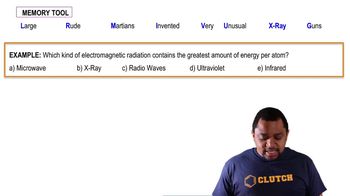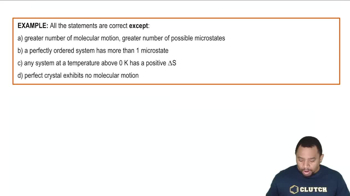Label each of the following statements as true or false. For those that are false, correct the statement. (b) Ultraviolet light has longer wavelengths than visible light.
Ch.6 - Electronic Structure of Atoms
Chapter 6, Problem 15a
Label each of the following statements as true or false. For those that are false, correct the statement. (a) Visible light is a form of electromagnetic radiation.
 Verified step by step guidance
Verified step by step guidance1
Step 1: Understand the concept of electromagnetic radiation. Electromagnetic radiation is a form of energy that is propagated through space as waves. It includes a range of different types of radiation, such as radio waves, microwaves, infrared, visible light, ultraviolet, X-rays, and gamma rays.
Step 2: Identify the position of visible light in the electromagnetic spectrum. Visible light is the portion of the electromagnetic spectrum that is visible to the human eye, typically ranging from wavelengths of about 400 nm (violet) to 700 nm (red).
Step 3: Evaluate the statement: 'Visible light is a form of electromagnetic radiation.' Since visible light is part of the electromagnetic spectrum, it is indeed a form of electromagnetic radiation.
Step 4: Determine the truth value of the statement. Based on the understanding that visible light is part of the electromagnetic spectrum, the statement is true.
Step 5: Conclude that the statement is true and does not require correction.

Verified video answer for a similar problem:
This video solution was recommended by our tutors as helpful for the problem above.
Video duration:
1mWas this helpful?
Key Concepts
Here are the essential concepts you must grasp in order to answer the question correctly.
Electromagnetic Radiation
Electromagnetic radiation is a form of energy that travels through space at the speed of light. It encompasses a spectrum of waves, including radio waves, microwaves, infrared, visible light, ultraviolet, X-rays, and gamma rays. Each type of electromagnetic radiation has different wavelengths and frequencies, which determine its properties and interactions with matter.
Recommended video:
Guided course

Electromagnetic Radiation Example
Visible Light
Visible light is the portion of the electromagnetic spectrum that is visible to the human eye, typically ranging from wavelengths of about 400 to 700 nanometers. It is composed of various colors, which can be seen in a rainbow, and is crucial for processes such as photosynthesis in plants and vision in animals. Visible light is just a small segment of the broader electromagnetic spectrum.
Recommended video:
Guided course

Visible Light Spectrum
True/False Statements
In logic and scientific reasoning, statements can be classified as true or false based on their accuracy and alignment with established facts. A true statement accurately reflects reality or scientific understanding, while a false statement contains inaccuracies. Correcting false statements involves identifying the error and providing the correct information, which is essential for clear communication and understanding in scientific discourse.
Recommended video:
Guided course

Third Law of Thermodynamics Example
Related Practice
Textbook Question
2
views
Textbook Question
Label each of the following statements as true or false. For those that are false, correct the statement. (c) X rays travel faster than microwaves.
2
views
Textbook Question
Determine which of the following statements are false and correct them. Determine which of the following statements are false and correct them. (a) The frequency of radiation increases as the wavelength increases. (b) Electromagnetic radiation travels through a vacuum at a constant speed, regardless of wavelength. (c) Infrared light has higher frequencies than visible light. (d) The glow from a fireplace, the energy within a microwave oven, and a foghorn blast are all forms of electromagnetic radiation.
2
views
